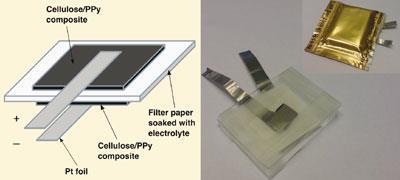Flexible, environmentally-friendly polymer batteries hold great promise for future technologies
Algae, paper and salt-water are the key components of thin and flexible new batteries, report Swedish researchers. Cellulose obtained from the bright green Cladophora algae proved to be key to the project, as it boasts a unique nanostructure with a high surface area.
Although the batteries have lower voltage and power density than conventional batteries, their low cost and flexibility hold great promise for applications where metal-based batteries are impractical.
The research is the product of a collaboration between two teams at Uppsala University in Sweden: Maria Strømme’s group, who identified the potential of the algal cellulose, and Leif Nyholm’s group, who were searching for new ways to improve the performance of conductive polymers.

’It turned out to be the perfect match,’ says Nyholm. ’The Cladophora cellulose is ideal for battery electrodes, as it has a very high surface area. This allows us to obtain larger capacities, but more importantly our device can be charged and discharged much faster than previously.’
To make the batteries, the team separated two cellulose electrodes with filter paper soaked in salt water. One of the electrodes is coated with a very thin layer of oxidised polypyrrole (PPy) while the other is coated with reduced polypyrrole. The potential difference between the two layers provides the voltage of the battery, as during charging and discharging, chloride ions move from one electrode to the other, similar to the way lithium ions cycle in lithium batteries.
A major advantage of the research is the simple and environmentally-friendly production method. ’Our batteries mainly consist of paper and salt water,’ Strømme told Chemistry World. ’So they can theoretically be made in your own kitchen, if you had a very strong mixer!’

The team have already started optimising the batteries, showing that they can comfortably withstand 1000 charge cycles. They are confident that further developments could lead to many exciting applications. 'Try to imagine what you can create when a battery can be integrated into wallpaper, clothing, or the packaging of your medicines,’ Strømme says.
The batteries can theoretically be made in your own kitchenMaria Strømme
'The concept of an all-polymer battery has long been attractive compared to metal-containing systems,’ says Duncan Gregory at the University of Glasgow in Scotland. 'The current approach has moved a long way towards overcoming many of the challenges. It will be very interesting to see how this work develops: ultimately, is this energy storage device a rechargeable battery, a capacitor or both?’
Hiroyuki Nishide, an expert on novel battery design at Waseda University in Tokyo, Japan, is also interested by the research - noting that while charging and discharging rates are good, the capacities still need to be improved. Nishide also adds that the work should inspire more research in this important field. 'Battery innovations like this will have an important role in realising future sustainable technologies,’ he says.
Lewis Brindley
References
G Nyström et al, Nano Lett., 2009, DOI: 10.1021/nl901852h






No comments yet